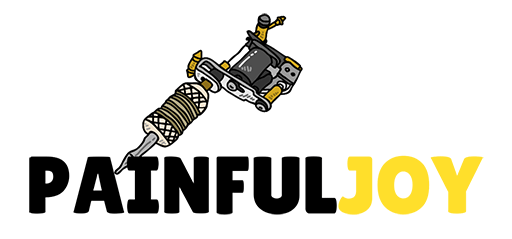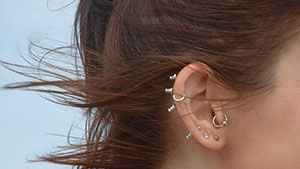The conch piercing, (pronounced “konk”), is one of the popular cartilage piercings. These piercings can be made on the inner or outer portion of the ear. They can also be adorned with simple stud earrings or with hoop earrings.
A lot of people wonder how long they have to wait after getting a conch piercing before they can change the jewelry in it. This waiting period is dependent on several factors and will be different from person to person. The normal amount of healing time for a conch piercing is 6 to 12 months.
Conch Piercing Procedures
The style of piercing that you choose will affect the amount of time it takes for the piercing to heal. There are two accepted methods of creating these piercings.
Needle
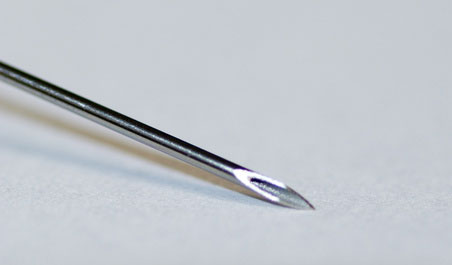
A piercing needle can be used in this process. The person doing the work will mark the location you prefer using a marker on both sides of the ear. Then the needle is inserted from the front to the back. They place the jewelry in position and provide you with aftercare instructions. The jewelry inserted first is generally a stud earring.
Dermal Punch
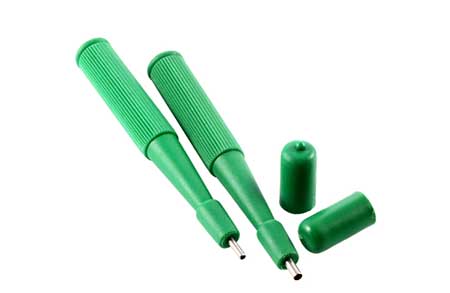
The dermal punch conch piercing is a specialty piercing. Some people like to wear larger items of conch jewelry that larger diameters. The holes in an earlobe can be stretched by simply placing the gradually larger pieces of jewelry in the hole until stretching occurs. The conch hole cannot be stretched in this manner. People who want to wear the larger jewelry will need to have a dermal punch hole created.
Traditional conch piercings that are created with a needle heal quicker than the ones created with a dermal punch.
Conch Complications that Slow Healing
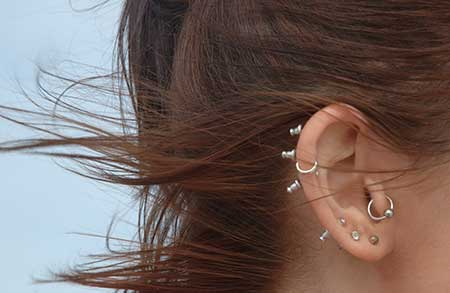
If your conch piercing heals perfectly then you can expect a 6-month wait before it is completely healed. Most piercing professionals suggest you wait until the wound has healed completely before you start changing out the jewelry because you can do damage to the area when making these changes.
The wound can heal much slower if everything does not heal perfectly. Some of the things that cause these wounds to heal slower are
- Diabetes and medical conditions that impeded healing. Many people who have conditions like diabetes are not aware they suffer with the disease. If your healing from the wound takes an abnormally long amount of time check with your doctor to make sure you do not have an underlying health issue.
- Infection of the wound. These infections occur in about 34% of this type of wound. You might experience fever, chills, pain, redness, or a discharge from the wound. Seek medical help if you have any of these symptoms or if the symptoms have gotten worse over a short period of time.
- Development of piercing pimple located in close proximity to the wound. These pimples often cause people to think they have an infection because of the pain and tenderness they create.
- Contact dermatitis which happens when you have an allergic reaction to the metal in the jewelry you are wearing.
- Keloid scarring which is raised scarring created by a collagen buildup. The scarring is typical not painful.
How to Speed Conch Piercing Healing

A lot of people would like to speed up their healing from a conch piercing. It is possible to do this by taking extremely good care of the wound and being diligent in avoiding practices that can slow the healing or create trauma around the wounded area.
Follow the below things
- Do clean the area frequently. You can clean the area as often as three or four times per day. Make sure you clean the area no less than twice a day.
- Use a saline solution of non-iodized sea salt and distilled water to clean the area. Saturate clean pieces of gauze with the saline solution and use the gauze to gently wipe around the piercing.
- Before cleaning your piercing wash your hands thoroughly with an antibacterial soap.
- Check in with your piercer and let them see and evaluate the wound.
Don’t do for Conch piercing healing
- Don’t sleep on your side with the pierced ear against a pillow or the bed.
- Do not remove the jewelry until your piercer says it is ok to do so.
- Don’t go swimming in public pools, private pools, creeks or natural water sources and allow the water to come into contact with your piercing.
Frequently Asked Questions
Does Conch Piercing Hurt?
A conch piercing is made in-ear cartilage and piercing ear cartilage is more painful than piercing the ear lobe. The level of pain is partially determined by how the piercing is done. A dermal punch piercing hurts more than a needle piercing. Part of the pain associated with the piercing occurs in the 48 hours after the piercing when most people describe a throbbing sensation occurring at the site of the piercing.
Do Conch Piercings Cost More?
Conch piercing does cost more than a single lobe piercing. They are sometimes as much as twice the price of a single lobe piercing. The difficulty with the piercing is the reason behind the elevated cost of the procedure. Also, these piercings are not usually done at kiosks in the malls, and at the jewelry counter of the local department store. You typically have to see a piercer at a shop or salon.
Are Conch Piercings Harder to Care for?
Many people would say that conch piercing is harder to care for compared to a lobe piercing. This is partially due to the fact that the conch piercing is done through cartilage that heals slower so the aftercare is done for an extended amount of time.
